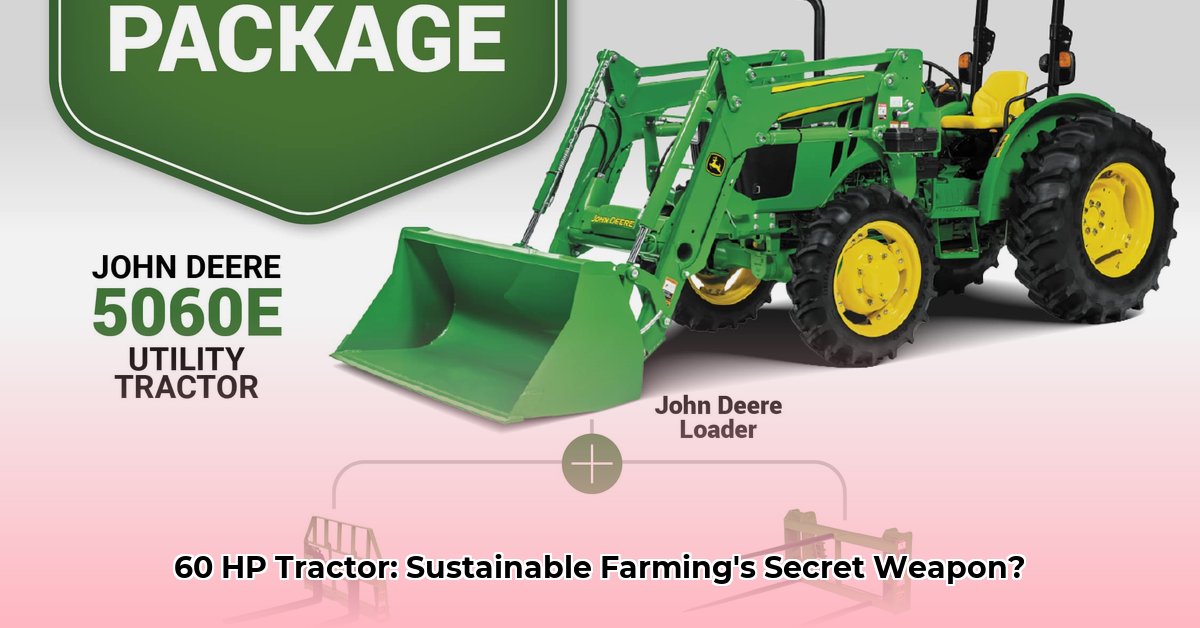
60 HP Tractor: Your Guide to Sustainable Farming Power
Choosing the right 60 HP tractor is a significant investment for any sustainable farm. This guide provides a step-by-step process to help you select the best model for your specific needs, balancing performance, fuel efficiency, and long-term cost-effectiveness. We'll explore key features, compare models (using hypothetical examples for illustrative purposes), and offer practical advice for making an informed decision. For more information on various tractor types, check out this helpful guide on different tractor types.
More Than Horsepower: Assessing Your Farm's Needs
Before you even browse tractor brochures, carefully assess your farm's characteristics. Consider your primary crops, the terrain (flat, hilly, etc.), typical farming tasks, and the overall scale of your operation. These factors directly influence the type of tractor you need. A tractor ideal for a small vineyard might be unsuitable for a large-scale grain operation. Detailed planning prevents future regrets.
"Understanding your farm's unique needs is the cornerstone of efficient tractor selection," says Dr. Anya Sharma, Agricultural Engineer at the University of California, Davis. "Ignoring these specifics can lead to costly mistakes."
Key Features: Beyond the Horsepower Label
While horsepower is crucial, several other factors significantly impact your choice, particularly in sustainable agriculture:
Fuel Efficiency: Fuel costs are a substantial expense. Look for tractors with proven fuel economy, utilizing advanced engine designs or smart fuel management systems to minimize environmental impact and operational costs. How much will fuel savings impact your bottom line over five years?
Maintenance and Reliability: Downtime is costly. Prioritize tractors with a history of reliability and simple maintenance. Easy access to parts is essential. Compare the cost and frequency of scheduled maintenance across models. A seemingly cheaper tractor might have far higher maintenance costs over its lifespan.
Maneuverability: In smaller fields or areas with obstacles, maneuverability is key. Consider turning radius and wheelbase. A shorter wheelbase often allows for tighter turns, improving efficiency in confined spaces.
Attachment Compatibility: Versatility is crucial. Ensure the tractor is compatible with the implements needed for various tasks throughout the year, maximizing its value and preventing the need for multiple specialized machines.
Technology: Precision agriculture technology, such as GPS guidance and auto-steer, can increase efficiency and reduce environmental impact. However, weigh the cost of these advanced features against your operation's specific needs. Are these features truly necessary, or would they represent an unnecessary investment?
Comparing Tractor Models: A Hypothetical Comparison
To illustrate the comparison process, let's consider three hypothetical 60 HP tractor models:
| Feature | Model Alpha | Model Beta | Model Gamma |
|---|---|---|---|
| Fuel Efficiency (gallons/hour) | 4.5 | 5.0 | 4.0 |
| Maintenance Interval (hours) | 250 | 500 | 300 |
| Turning Radius (feet) | 15 | 12 | 18 |
| 3-Point Hitch Capacity (lbs) | 2500 | 3000 | 2000 |
| Estimated Price (USD) | $25,000 | $28,000 | $22,000 |
This table highlights the trade-offs common among different models. Model Gamma offers superior fuel efficiency but a larger turning radius, while Model Beta boasts a smaller turning radius but higher fuel consumption and more frequent maintenance. Prioritize features based on your farm’s unique requirements.
Your Step-by-Step Guide to Tractor Selection
Define Your Needs: Thoroughly document your farm's size, terrain, typical tasks, and future plans. This forms the basis for your tractor selection.
Research and Compare: Use online resources, farm magazines, and dealer brochures to compare models that meet your defined needs. Engage with online farming communities for real-world feedback.
Consult with Experts: Talk to local dealers and experienced farmers. They can offer valuable insights based on local conditions and their firsthand experience with different tractor models.
Test Drive (If Possible): A test drive allows you to assess the tractor's handling and features firsthand under realistic conditions. Try to simulate your typical farming scenarios.
Calculate Total Cost of Ownership: Consider the purchase price, fuel costs, maintenance expenses, and potential resale value for a complete financial picture.
Make Your Decision: Weigh all collected information before making your final decision. Don't hesitate to walk away if you have any doubts.
Sustainability Beyond the Tractor
Choosing a fuel-efficient tractor is only one aspect of sustainable farming. Complement your tractor choice with practices like no-till farming, crop rotation, and precise application of fertilizers and pesticides. These techniques, combined with a well-chosen tractor, enhance soil health and minimize environmental impact.
Choosing a 60 HP tractor is a substantial investment. This guide aims to provide a structured approach, ensuring your choice is aligned with both your farming needs and your sustainability goals.